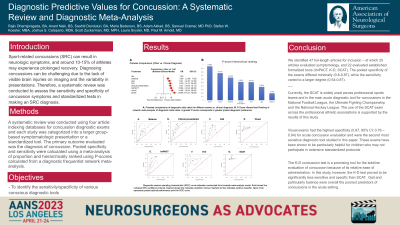Diagnostic Yield of Tests for the Diagnosis of Sports-Related Concussion: Diagnostic Meta-Analysis
Diagnostic Yield of Tests for the Diagnosis of Sports-related Concussion: Diagnostic Meta-analysis
Friday, April 21, 2023


Rajiv Dharnipragada, BS
Medical Student
University of Minnesota
Medina, Minnesota, United States
ePoster Presenter(s)
Introduction: Sport-related concussions (SRC) can cause significant neurologic symptoms, and approximately 10-15% of athletes experience a prolonged recovery. Due to the lack of visible injury on brain imaging and varied presentations, concussions can be difficult to diagnose. A variety of tests and examination methods are used to elicit a concussion diagnosis; however, the sensitivity and specificity of these tests are variable. We sought to perform a systematic review to evaluate the sensitivity and specificity of concussion symptoms and standardized tests in making the diagnosis of an SRC.
Methods: A systematic review was conducted using four article indexing databases for concussion diagnostic exams and each study was categorized into a larger group-based symptomatologic presentation or a standardized tool. The primary outcome evaluated was the diagnosis of concussion. Pooled specificity and sensitivity were calculated using a meta-analysis of proportion and hierarchically ranked using P-scores calculated from a diagnostic frequentist network meta-analysis.
Results: We identified 47 full-length articles for inclusion – of which 25 articles evaluated symptomology, and 22 evaluated established formalized tools (ImPACT, K-D, SCAT). The pooled specificity of the exams differed minimally (0.8-0.87), while the sensitivity varied to a larger degree (0.54-0.87). Using a random-effects model, the SCAT had the greatest diagnostic yield (dOR = 29.96 (95% CI: 11.81 – 76.00). Additionally, P-score hierarchical ranking revealed SCAT to have the greatest preference for diagnostic utility (P = 0.9843). Deficits in visual acuity had a greater preference in P-score ranking than IMPACT and K-D (P = 0.7727 vs. 0.6438, 0.5172, respectively).
Conclusion : The rapid diagnosis of concussions is of principal importance to the sports community. Our analysis demonstrates that SCAT has the greatest diagnostic yield compared to other measures, though other measures may be comparable. Given the indirect nature of our analysis, however, further comparative studies are needed to validate our findings.
Methods: A systematic review was conducted using four article indexing databases for concussion diagnostic exams and each study was categorized into a larger group-based symptomatologic presentation or a standardized tool. The primary outcome evaluated was the diagnosis of concussion. Pooled specificity and sensitivity were calculated using a meta-analysis of proportion and hierarchically ranked using P-scores calculated from a diagnostic frequentist network meta-analysis.
Results: We identified 47 full-length articles for inclusion – of which 25 articles evaluated symptomology, and 22 evaluated established formalized tools (ImPACT, K-D, SCAT). The pooled specificity of the exams differed minimally (0.8-0.87), while the sensitivity varied to a larger degree (0.54-0.87). Using a random-effects model, the SCAT had the greatest diagnostic yield (dOR = 29.96 (95% CI: 11.81 – 76.00). Additionally, P-score hierarchical ranking revealed SCAT to have the greatest preference for diagnostic utility (P = 0.9843). Deficits in visual acuity had a greater preference in P-score ranking than IMPACT and K-D (P = 0.7727 vs. 0.6438, 0.5172, respectively).
Conclusion : The rapid diagnosis of concussions is of principal importance to the sports community. Our analysis demonstrates that SCAT has the greatest diagnostic yield compared to other measures, though other measures may be comparable. Given the indirect nature of our analysis, however, further comparative studies are needed to validate our findings.
